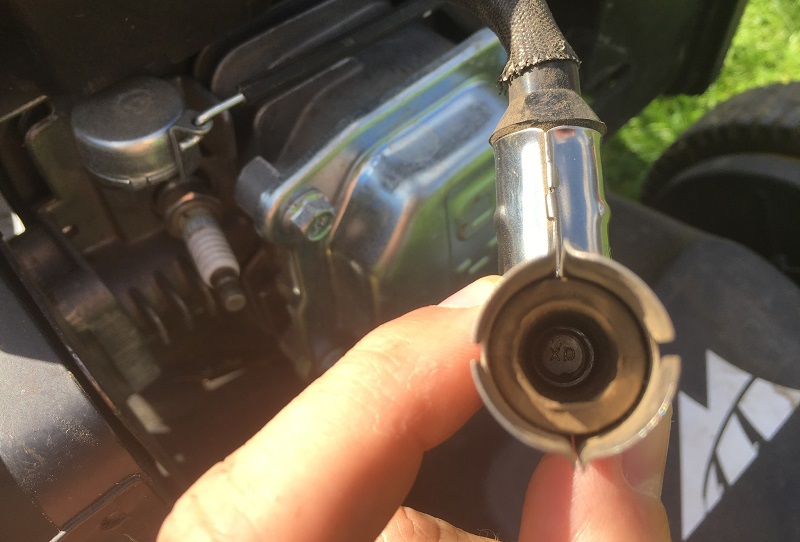If you have spent any length of time using a gas-powered lawn mower, you may have come across the problem of a bad spark plug.
A spark is needed for the internal combustion engine to run, and a spark plug is essential to the function of your lawn mower.
Luckily it is an easy and inexpensive fix, and it’s a problem that is usually easy to spot too!
How to Tell When a Lawn Mower Spark Plug is Bad?
If you are experiencing problems starting your mower or keeping it running, you feel that it’s lacking some power, or if you are burning through more fuel than usual, it may be the spark plug that is to blame.
Some Common Symptoms of a Bad Spark Plug:
If you’re not that technical and don’t normally mess around with tools and equipment, you might think that you won’t have any clue if anything happens to your spark plug.
But luckily for you, there are a number of pretty obvious ways to tell a lawn mower has a bad spark plug.
I’m going to outline some of the more common symptoms below.
The Lawn Mower Will Not Start
If your lawn mower will not start at all, no matter how many times you pull the cord or turn the ignition, this could be an indication that the spark plug is bad.
There needs to be a spark in the combustion chamber to ignite the fuel, and no ignition may mean that this spark is not present.
The Mower Takes More, Harder Pulls of the Cord to Start
If you are pulling and pulling on the cord or pulling extra hard trying to get the engine to turn over, this may mean that your spark plug is on its way out.
With a new plug, one pull should give a sufficient spark to start the combustion process, but if this spark is weak or not happening at all, there is nothing to ignite the fuel.
The Lawn Mower has a Rough Idle or is Lacking Power
If your mower is struggling to cut grass that it would normally have no problem with, the engine may not be getting the spark it needs to keep it running at full power.
Also worth noting is any change in the way the engine sounds while running.
You are Refueling the Mower More than Usual
When a spark plug is intermittently failing, the engine will not be burning the fuel completely in the combustion chamber, thus leading to a decrease in hours of use from one tank of fuel.
So if you’re filling up the tank more than you used to, this can be a sign of a bad spark plug.
Will a Bad Spark Plug Cause a Mower Not to Start?
In short, yes. Your mower’s engine relies on the spark from the spark plug to ignite the aerosolized fuel that enters the combustion chamber. Without this spark, the combustion can not happen.
The combustion is what propels the piston within the engine and without it, the engine will not run at all.
It remains “asleep”, rather like my kids at the weekend. They need a shock or a spark to get going too!
What to Do When You See the Symptoms of a Bad Spark Plug?
If you have spotted these symptoms in your lawn mower and want to check the spark plug, you will need to do some very simple mechanical work.
But don’t panic, this is one of the easiest maintenance tasks you can perform on your own lawn mower, and is manageable for most people.
Here’s how you do it:
1) Disconnect the Spark Plug Lead
This is usually just a flexible rubber shroud that fits around the ceramic end of the spark plug and contains a metal contact.
All you need to do is carefully pull this rubber cap from the plug. It may require some wiggling back and forth to remove.
2) You Will Need a Spark Plug Socket to Remove the Plug
This is a socket that is specifically designed to remove a spark plug without causing damage or harm to yourself or the engine.
You slide the socket over the spark plug and turn, lefty-loosey, until the plug is free to be removed.
3) After Removing the Plug
You can now check for damage to the plug and determine if you have a bad spark plug.
Damage may look like black carbon build-up on the electrodes, electrodes that have been worn down, a cracked ceramic coating on the plug, or evidence of oil on the end of the spark plug.
4) Decide Whether to Clean or Replace the Spark Plug
There are many cases where a spark plug can be cleaned and continue to be used.
If the electrodes on the end of the plug are still sharp and full length, they may still create a sufficient spark.
You can use a soft wire brush and a rag to clean off any carbon build-up or oil from the surface of the spark plug.
Oil on the plug is an indicator of another problem within the engine, as seals have probably degraded enough to allow it to enter where the plug is seated.
If you decide to replace the spark plug, they are quite inexpensive and can be found at most home improvement supply stores.
Replacing the spark plug regularly can be a good piece of preventative maintenance to perform on your lawn mower.
How often should you change your lawn mower spark plug? I typically just run with once per season, but it does depend somewhat on how much you mow.
Most spark plug manufacturers recommend they be changed every 25 hours.
5) Reinstall the Spark Plug
Whether replacing or cleaning the spark plug, you will have to reinstall it the same way you took it out.
Be careful not to allow any debris or dirt to enter the area where the plug will be installed.
Take the plug, thread it into the engine, in the same way you removed it, but righty-tighty this time.
Be careful though, as spark plugs are not meant to be cranked down tight- the recommended torque is 15 ft. lbs.
A Quick Summary
If you are having a hard time getting your lawn mower to start, the spark plug may be the culprit.
Worn or damaged spark plugs will not produce a spark as easily (or at all), causing the ignition of the engine to be all but impossible to achieve.
Checking for the signs and symptoms described above may point you in the right direction when troubleshooting a bad spark plug in your lawn mower.




Leave a Reply